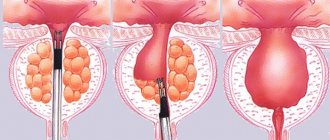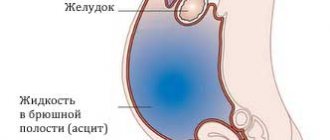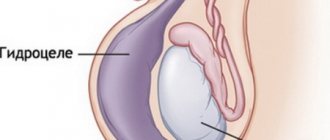Phimosis and paraphimosis are called narrowing of the foreskin of the penis. With phimosis, it is impossible to expose the head of the genital organ. Paraphimosis, on the contrary, is a complication in which the head is difficult to “close”. Its narrowing occurs due to pinching of the foreskin during sexual intercourse or masturbation.
Author:
- Sorokin Nikolai Ivanovich, head of the urological service of the university clinic of Moscow State University. M. V. Lomonosova
2.80 (Votes: 5)
Anatomical and physiological aspects
The formation of the penis begins from the 7th week of pregnancy and ends at the 17th week. The skin of the penis folds in front to form the foreskin and preputial sac. It performs many functions, the main ones being protective, immunological and erogenous. The foreskin is represented by a two-layer skin fold that merges with the head of the penis. It is connected to the undersurface of the glans penis by a highly sensitive tissue called the frenulum. The prepuce is richly vascularized and innervated. Conventional circumcision removes most of these sensitive areas. The glands present on the foreskin and glans produce a secretion containing lysozyme, which has a protective function. At birth and in the first few years of life, the inner part of the foreskin is intimately fused to the head of the penis and, therefore, the latter is not removed.
Physiological phimosis is observed in the first years of life and is associated with the presence of synechiae between the foreskin and the head. The foreskin gradually becomes more mobile with age and allows more and more exposure of the head of the penis. This is facilitated by erection, retraction and keratinization of the epithelium of the inner layer of the foreskin. Thus, the possibility of exposing the head of the penis increases.
With pathological phimosis, the altered foreskin looks like a cone-shaped “cover” with a distal narrow part, which can be fibrous. It is important to distinguish pathological phimosis from physiological one, as this completely changes the tactics of observation and treatment. Physiological phimosis requires only conservative treatment, pathological phimosis can only be corrected through surgery.
Poor hygiene and repeated episodes of balanitis or balanoposthitis lead to the formation of scars on the inner layer of the foreskin, which leads to pathological phimosis. Strong retraction leads to microcracks in the opening of the preputial sac, which also leads to the formation of scars and phimosis. Older people are at risk for phimosis secondary to loss of skin elasticity and infrequent erections.
Symptoms of pathological phimosis in men may include painful erection, hematuria, recurrent urinary tract infection, pain in the foreskin, weakness, straining of the urine stream, and a feeling of incomplete emptying of the bladder.
Up to 10% of men have physiological phimosis before the age of 3 years, and a larger percentage of children will have only partially retractable foreskin. 1-5% of men have phimosis by age 16.
Phimosis treatment methods
Treatment of phimosis is surgical; the purpose of the operation is to rid the patient of phimosis, prevent balanoposthitis, penile cancer, urinary retention, genitourinary tract infections, and improve the quality of life.
In Moscow, regarding the treatment of phimosis, you can contact JSC “Family Doctor”.
Highly qualified urological surgeons at the Family Doctor will perform circumcision (surgery for phimosis). The operation is performed under local anesthesia.
Circumcision (cutting of the foreskin)
The only effective treatment for phimosis is surgery. As a rule, circumcision is performed - circumcision of the foreskin. In case of complications (balanoposthitis or paraphimosis), a longitudinal dissection of the foreskin is first performed. Longitudinal dissection solves the problem of opening the head, but in this case, after some time, it is recommended to carry out circumcision for cosmetic purposes.
More information about the treatment method
Make an appointment Do not self-medicate. Contact our specialists who will correctly diagnose and prescribe treatment.
Rate how useful the material was
thank you for rating
Reducing the risk of contracting STDs and developing urinary tract infections
The first advantage of circumcision is that it reduces the risk of contracting sexually transmitted diseases. During the procedure, tissues that are most sensitive to infectious agents are removed. According to statistics, the risk of becoming infected with the human papillomavirus is reduced by 32-35%, and genital herpes – by 28-34%. According to other data, in Israel, where circumcision is very popular, syphilis is less common among men.
Circumcised men suffer from genitourinary infections 10 times less often. This is due to the fact that they do not have a foreskin, under which harmful bacteria can accumulate.
Recovery after circumcision
Since the procedure is usually performed in a hospital, the adult patient usually goes home after the anesthesia wears off. The child may be left for observation in a medical facility for some time.
It is necessary to maintain penile hygiene by rinsing with warm boiled water using soap with neutral pH, treating with antiseptics recommended by your doctor, and applying a sterile bandage.
For adult circumcision, sexual intercourse is prohibited until the wound has healed (about 6 weeks). The doctor will usually give instructions on how to clean the incision and relieve pain.
It is recommended to avoid sports and strenuous physical work during the first four weeks of recovery.
Patients are advised to take 5 - 10 mg of diazepam in the evening for the first 2 - 3 days after the procedure to prevent morning erections. It can be painful and will cause the stitches to come apart.
Is it possible to do circumcision at home?
Circumcision on your own is called self-mutilation. Such manipulations are fraught with fainting, bleeding, blood poisoning, and ugly scars. If you can’t get to the doctor’s office with the question of circumcision, then theoretically you can call him to your home. Many religious families practice this, inviting relevant representatives of the community. It is difficult to persuade an ordinary surgeon to perform home circumcision, since if complications arise, he seriously risks his profession. Such manipulations fall under Article 235 of the Criminal Code of the Russian Federation on the illegal implementation of medical activities.
Frequently asked questions
- Does circumcision affect penis size? - No. Circumcision does not affect the cavernous bodies and the glans.
- When can you start playing sports? – It all depends on the cutting method and the condition of the seam. As a standard, you can study after 2 weeks.
- When can you shower? – The day after surgery, but with penis protection. The seam can be wetted after 2 days, but do not soap or wipe it.
- How to go to the toilet after circumcision? − In the first days after circumcision, the urethral sponges may stick together, crusts and swelling may appear on them. In such cases, urine splashes and gets everywhere, including on the seam. To avoid this, before urinating, you can apply the cut-off body of a 20 ml syringe to the urethra.
- Is sick leave given after circumcision? – Sick leave will only be given if the circumcision is performed in a public clinic and the hospital stay is at least a week. If the operation is done in one day and without complications, then they do not give it.
- When can you go to the bathhouse or swimming pool? – In 3 weeks, when the stitches are removed and the marks from them have healed.
Myths and facts about circumcision
Here are some of them:
- Female circumcision - the term circumcision does not only refer to the male part of the population. It is frowned upon in modern society and is prohibited by law in most countries. But female circumcision does exist and involves the removal of the external parts of the female genitalia. It has no health benefits, but on the contrary, most often causes complications.
- Hygiene - with proper care there is no difference in the hygiene of circumcised and uncircumcised persons.
- Sexual intercourse – you should not have sexual intercourse unless you are recovering from circumcision. Some even consider circumcision an advantage because relationships can last longer - circumcised men have a higher degree of sensitivity. But from a woman's point of view, nothing changes.
Reviews from men
Judging by the reviews on the forums, everyone is happy with the result of circumcision, but most have a rather difficult time with the first 2 weeks of recovery . After 2 months, men are already living full lives. Examples of reviews are below.
HOW IS THE TREATMENT PRODUCED IN OUR CLINIC?
In order to undergo treatment with us, please study this small section. You will have all the information, and it will be easier for us to conduct a dialogue.
- Check out this information:
- The price of the operation and what is included in the price
- What you need to know about the operation and how to prepare for it
- If you are having surgery to increase the duration of sexual intercourse, do a test with an anesthetic
- Look at the results and reviews from our patients to get an idea of how the healing is progressing and what the post-operative scar will look like.
- Contact us by email. email [email protected]
- Provide information about yourself and what you want to do. We will respond as soon as possible (usually within 1 day).
- In correspondence we will resolve the necessary issues.
- If there are many questions or it is difficult to discuss them by mail, we will invite you to an in-person meeting. But, as a rule, this is not required.
- Of course, we are always glad to see you! So, if you want, come for a consultation, let’s talk (indicate this in the correspondence).
- Together we will choose the date of the operation! We will send all the instructions: what you can and cannot do, how to prepare.
- You need to arrive at the clinic at the appointed time and tell the receptionist your name and that you are booked for an operation with Dr. Babykin.
- It is necessary to fill out the contract and pay for the operation. (The administrator will already have all the information about you and your operation)
- You will be taken to your room and told what to change into. Everything will be given out, you don’t need to take anything with you!
- Before the operation we will talk, I will answer your questions and ask mine.
- We will come to the operating room together, I will help you lie down on the operating table.
- It will take some time to prepare and treat the operation area.
- We will begin the operation and immediately administer anesthesia. It won't hurt!
- You can talk to us during the operation, but you must not disturb us.
- We will take you to the ward, where you will need to lie down for a while.
- We'll give you all the instructions and send you home.
- Observation, as a rule, takes place remotely - through a forum or by e-mail. Of course, you can come and show yourself - all this is included in the cost of treatment.
- The most important thing is to follow our recommendations and inform us about your condition every few days (just write a few words and attach a photo so that we understand that you are doing well).
- The sutures are absorbable and do not need to be removed. But if you really want to, you can come to the clinic or remove them yourself.
Diseases of the foreskin in men
The foreskin serves as additional protection for the intimate area, but often men are faced with diseases that are associated specifically with it. And so, the most common pathologies of the male foreskin include the following problems:
- phimosis or inability to fully open the head;
- physiological phimosis – characteristic of infants and does not require treatment;
- pathological phimosis, which has 4 stages;
- paraphimosis – a complication of phimosis;
- balanoposthitis - inflammation of the head of the intimate organ and foreskin;
- Lichen sclerosus is a precancerous disease.
Do you consult a doctor on time to identify diseases at an early stage?
Not really
All these pathologies require treatment in adult men, which consists precisely at the moment of need to remove the foreskin.
How to treat phimosis?
When wondering how to cure phimosis, many men rely on the use of traditional methods, which in most cases come down to the use of baths and lotions made from natural herbs. To carry out competent therapy, it should be understood that this method of treating phimosis in men is ineffective and can only have a weak anti-inflammatory and analgesic effect. Two main methods are considered effective methods for getting rid of phimosis:
- Method of stretching the foreskin;
- Surgical correction of narrowing.
Symptoms of phimosis and paraphimosis
The main symptom of phimosis is difficulty in exposing the head of the penis, which may result in problems with urination.
During sexual intercourse, symptoms such as tears in the foreskin, bleeding, a feeling of pain, straining during urination, pain during erection, a feeling of skin tension, decreased potency as a result of psychological stress and pain may occur.
A symptom of paraphimosis is the inability to return the foreskin to its original position, which can result in pain, swelling, and blue discoloration of the organ. Also, closure of the head can cause lymphatic or venous congestion and impaired arterial bleeding. Pinching the head of the genital organ contributes to an increase in swelling and enlargement of the head itself, resulting in pain even at the slightest touch. Urination is usually difficult. If the foreskin does not return to its original position for a long time, diseases such as ischemia, partial necrosis of the glans penis, or the development of gangrene develop.
Reducing the risk of contracting HIV infection
According to statistics, the majority of men who contracted HIV through sexual contact had uncircumcised foreskin. The increased risk of infection is explained by the fact that this part of the head of the penis is most susceptible to microtrauma, through which infection occurs more easily.
The cells of the foreskin mucosa are most vulnerable to HIV. Therefore, circumcision was recognized as a method of preventing infection with this infection. Although there is an opinion that this advantage only applies to residents of Africa, since countries on other continents have free access to condoms that are more effective in protecting against HIV.
Reasons for circumcision
The content of the article
Circumcision is often associated with religion. But today there are several reasons why people undergo foreskin removal for children or undergo this procedure themselves at a conscious age.
Religious and cultural reasons
Circumcision is performed as part of a ritual at certain ages depending on religion and culture. This procedure is a religious obligation in Islam and Judaism and some African countries. It marks the boys' entry into the world of adults and is performed on an eight-day-old child.
Health and medical reasons
Many people believe that circumcision has many health benefits that outweigh the potential risks. Adults may choose circumcision due to frequent inflammation, phimosis, or paraphimosis. Many pediatricians also recommend circumcision to reduce the occurrence of further complications.
Aesthetic reasons
Some people simply prefer the look of a circumcised penis.









